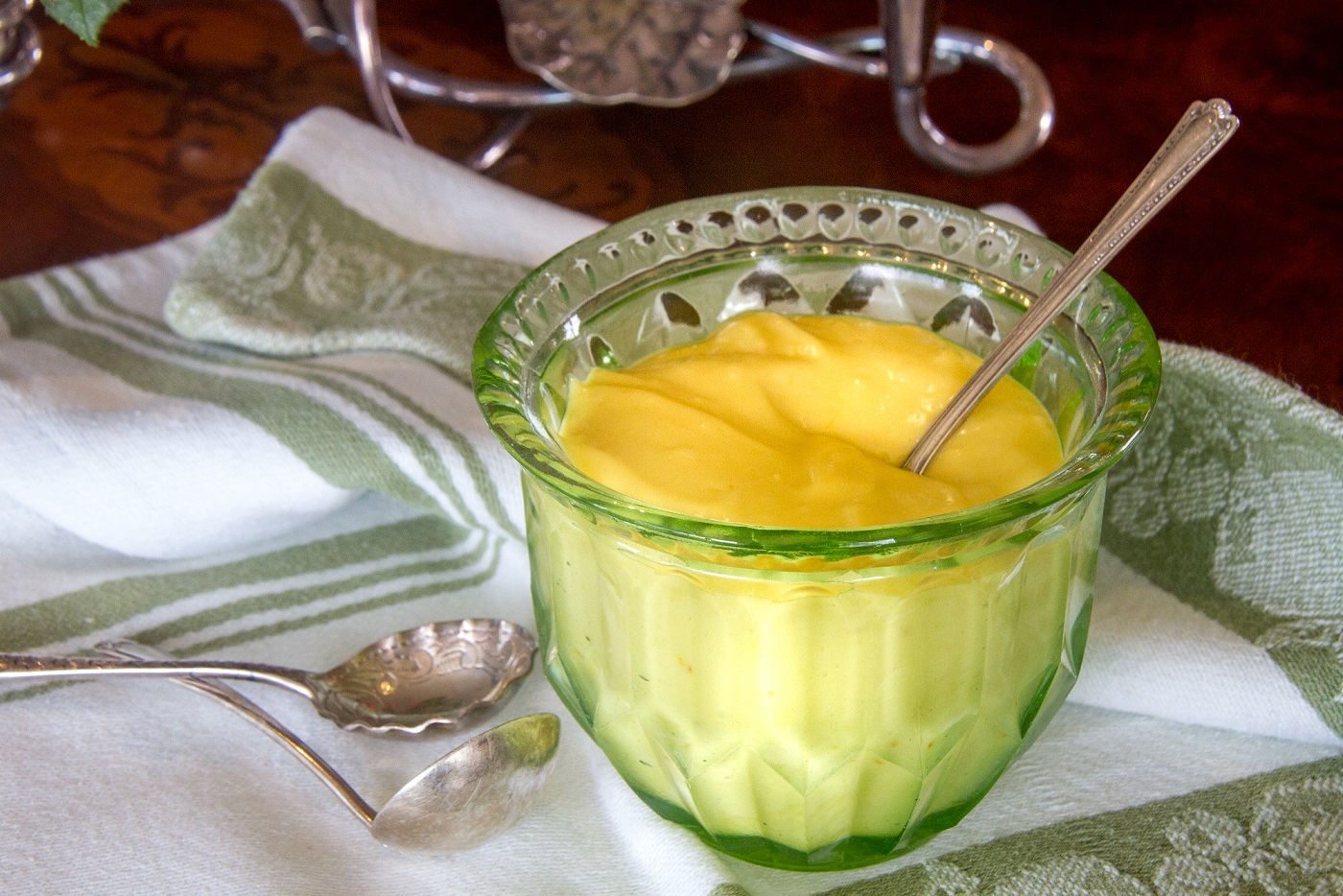This beautiful home-made mayonnaise enhances everything it touches, with its custardy richness and delicate tang that gives a clean and clear flavour that commercial mayonnaise does not have.
When making this sauce, do remember to take your time and go slowly, drop by drop, at the beginning for the addition of the oil. The whole process takes about 10 minutes, so relax and enjoy it. The skill is in the making of the emulsion, which is the combining of two liquids that don’t like to mix together. If you add the oil too quickly, you have a very strong likelihood of the mayonnaise separating or breaking up, and then you have to start again!
Makes about 300 grams
| Ingredients | |
| 2 egg yolks 1 tsp Dijon mustard ½ tsp salt ¼ tsp white wine or cider vinegar |
1½ – 2 tbsp lemon juice 370ml lightly flavoured olive oil White pepper 1 – 2 tbsp water, if the mayonnaise is too thick or add some more lemon juice to taste
|
Creating of the mayonnaise emulsion: the skill in the making of mayonnaise is the creation of the emulsion – the combining of two liquids that don’t like to mix together. Mayonnaise is a dense emulsion made up of tiny oil droplets tightly packed together, but not actually touching. The key to a stable emulsion is to keep these tiny oil droplets separate; if they merge the emulsion collapses. That is why emulsions contain emulsifiers to stabilize the mixture; in mayonnaise, the emulsifier is the lecithin in the egg yolks, and in the mustard, it is the polysaccharides. These emulsifiers form a thin barrier around each tiny oil droplet so they co-exist without breaking down. Vigorous whisking causes the two ingredients to break into very tiny droplets that are suspended in, and separated, by the other. The oil droplets are surrounded by the emulsifiers to keep them separate and so the emulsion is formed. If the oil droplets merge, the mayonnaise breaks down, separates and becomes an oily greasy liquid.
Simply, if you add the oils too quickly, without creating the emulsion early in the process, you have a very strong likelihood of the mayonnaise separating or breaking up, and then you have to start again!
Before starting to make the mayonnaise make sure all your ingredients and bowls are at room temperature. If the oil is cold, heat it to tepid.
Use a medium sized, clean and dry, ‘warm’ bowl and rest it on a warm, damp cloth to stop it slipping.
Separate the eggs, reserve the whites for another use or freeze them.
Work egg yolks with your whisk or wooden spoon for 2 minutes until they are thick and sticky. This is the beginning of the formation of the emulsion, the working of the emulsifier, lecithin, in the egg yolks.
Then add the Dijon mustard, the polysaccharides in the mustard are another emulsifier. salt, vinegar and one tablespoon of the lemon juice and beat until very thick, at least 30 seconds. This is an important part of the process as it begins the forming of the emulsion.
Now the eggs are ready for the oil. Wrap a tea towel around the base of your bowl to stop it from moving and very slowly drip the oil in, drop by drop, whisking constantly, until creamy and thick. As the mixture thickens, and you have added about half the oil, you may increase the oil additions to a very thin trickle until it is all added.
Adjust the seasonings and add extra lemon juice or water if needed.
For saffron mayonnaise: add 4 -5 saffron threads to 20ml of boiling water to infuse for a few minutes. Then add the threads and the infused water to the egg yolk with the lemon juice. Whisk well with the mustard and make as above.
How to remedy a separated or broken mayonnaise
- There are a few methods to rectify a separated or broken mayonnaise; this method works well for me.
break an extra egg yolk into a clean, warm bowl and slowly work in the broken, separated sauce, a little at a time until the sauce has reconstituted and re-emulsified.
*Elizabether David – on making mayonnaise she said…’I do not care, unless I am in a great hurry, to let time deprive me of the pleasure and satisfaction to be obtained from sitting down quietly with a bowl and spoon, eggs and oil, to the peaceful kitchen task of concoting the beautiful, shining oinment which is mayonnaise’. She described mayonnaise as the ‘beautiful golden oinment-like sauce’ which is ‘the pivot and rain d’etre of the whole affair’!
In Jonathan Green’s fabulous RN radio program Blueprint for Living, food writer Jenny Linford talked about her new book called ‘The missing ingredient: the curious role of time in food and flavour’. Saturday 6th October, 2018. Do listen to it when you have some ‘time’!
How to prolong the life of your mayonnaise.
I am not keen on pasteurizing the egg yolks like this and I so I do not do this. I prefer to make the mayonnaise as I need it.
To prolong the fridge life of your mayonnaise, you need to ‘do it yourself’ pasteurise the egg yolks by taking them to 160℃ in the microwave oven. To do this you need to add 60ml water and 4 teaspoons of lemon juice to the egg yolks, and whisk well. This mixture kept the egg proteins separate and prevents the eggs becoming semi-solid. Turn microwave on and off and stir well until the 160160℃ is reached. Immediately start whisking in the oil, to cool down the mixture and to prevent the proteins from thickening the mixture.






